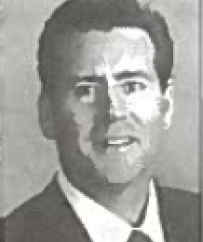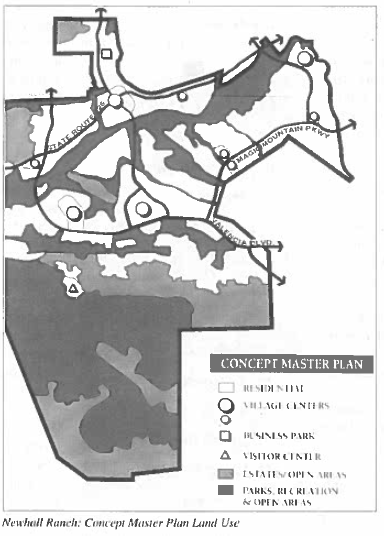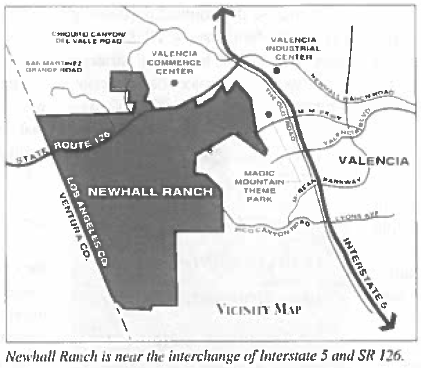Newhall Ranch, approximately 12,000 acres (nearly 19 square miles) located just east of Valencia, is the largest planned community ever seen in Los Angeles County. The land is owned and being developed by The Newhall Land and Farming Company, who also developed Valencia, the first planned community in the Santa Clarita Valley. Newhall Ranch’s Environmental Impact Report (EIR) and specific plan are expected to be submitted for review by Los Angeles County in early April.
In light of the significance and size of the proposal, TPR presents an interview with James Harter, Senior Vice President for The Newhall Land and Farming Company, and Project Manager for Newhall Ranch.

James Harter: “The river, the wya you see it now, will be the way it will remain."
Jim, please put the proposed Newhall Ranch development in context for our readers—what is its history, how does it relate to adjoining communities, and how does it fit in with Newhall Land's long term plans for North County?
We have been developing Valencia for about 25 years. We see the ultimate completion of Valencia on the horizon, and we are looking at meeting the continued demand for housing and growth of employment in North Los Angeles County.
We see Newhall Ranch as a logical extension of existing communities. We already have much of the infrastructure: we have major regional transportation corridors in the area, and we have all of the utilities going through, or adjacent to the property. Newhall Ranch makes a logical extension of the existing infrastructure.
We also have a number of the other amenities within the community, including a trauma center at the hospital, community college and the Los Angeles County operations center. With the forecast growth of Los Angeles County for the next 20 to 25 years as large as it is, and as we approach buildout of Valencia, Newhall Ranch is a logical extension of where development will go.
What is the acreage of this development, and what do you anticipate Newhall Ranch's expected population and number of homes to eventually be? More specifically, what is the Ranch's specific plan likely to include when submitted to the L.A. County Regional Planning Commission this summer?
The project is 12,000 acres—at most 19 square miles. While we acknowledge that this is a large project, we also see nature as the prevailing theme in all of the planning for the project. We're taking an excellent project to the Planning Commission, with 49% of the land continuing to be open space. The remainder of the property will be home to approximately 70,000 people. We have developed a well-integrated land use plan which includes 19,000 permanent jobs to complement housing for 70,000 people.
Newhall Land in the 1960's started Valencia, which was the first major planned development in the Santa Clarita Valley. Now that Valencia is half built-out, what lessons have you learned in developing Valencia that you will be incorporating into Newhall Ranch?
The population of Valencia now is about 33,000 people, and Newhall Ranch will likely be comparable in population to Valencia when it is built out. I think that one of the lessons we have learned in Valencia is the need for employment. This has been a major emphasis with our company—to try to bring employment and employers to the community. Without employment you don't have the economic growth that is necessary for people to buy homes.
The other thing we have learned is how to better address the market, and find out what people want in their community and in the homes that they buy. This is important-we can build a community, but if it's not what people want, they won't buy. Watching the market very closely and trying to address people’s desires is one of the more important lessons we have learned.
Elaborate on the planning concepts that your planners have relied upon and that will form the foundation for the specific plan and EIR of the new community.
We have found that people like the suburban lifestyle, but they want an intimate community. We believe people essentially want a small town feel. To accomplish this, we have taken our entire community of Newhall Ranch and divided it into five separate villages. Because of the amenities, the topography and the natural features, each one of those communities will have its own distinct personality and will be different from the other four villages.
The community will have the amenities that we've identified through both local and national surveys. Trail systems are a popular feature, and we're going to have an extensive trail system along the river and up into the high country mountains. The trails will link the villages to each other and the villages within themselves.
The community is going to be a combination of residential, commercial and employment opportunities, but each one of our villages is oriented around a mixed-use center. This center allows creativity in being able to combine residential, commercial, recreation, and perhaps public facilities in the same area, yet integrating them creatively and more efficiently. Shared parking is an example.
Around each one of those village core's mixed use areas, we will have higher density residential homes; as the topography gets steeper, and more distant from the village centers, we will have larger lots with lower-density housing.
Obviously, Newhall Land and Farming has been involved in, and watched communities—"new towns"—develop over the years. Are there models/lessons from others or your own experiences that have influenced the planning of the Ranch?
A number of communities across the nation have this concept of a town center and a focal point for each one of their communities. Santa Margarita is an example of this type of design. Reston, and even right here in Valencia, has a town center anchored by the regional mall.
When we look at other planned communities across the country, two of the most desired features are a trail system and open space. Those are two of the major amenities that people are looking for in a planned community.
In Newhall Ranch we are going to have a tiered and extensive trail system. We will have much wider trails which will be heavily used by bicycles and pedestrians, and in the more environmentally-sensitive areas, such as the high country, we will have unimproved trails, which will be narrower and have less impact on the environment.
Give our readers an account of Newhall Ranch's efforts to gain approval of both the Ranch's EIR and the specific plan from the county regulatory authorities.
We performed about a year's worth of preliminary planning before we submitted, in June, 1994, an application to the County of Los Angeles for a general plan amendment and specific plan for the project.
Each of the individual departments at the County has reviewed sections of the EIR. We are consolidating the plan and EIR for their final comprehensive review by County agencies.
During this same time we have had an extensive community relations program. We have made slide presentations to every community group that we could identify, and we have formed a community task force, through which we have invited the community to meet with us and all of our consultants.
What do you expect to encounter over the next six months?
We expect that by the end of March, county agencies will start their formal final review of the Environmental Impact Report and the specific plan. In June we hope those documents will be released for public comment. We expect that by the end of August or possibly September we will start our Regional Planning Commission hearings.
Elaborate on what you believe the need for new homes in L.A. County will be in the next twenty years, and what you estimate Newhall's market niche over that same period to be?
Based on projections by the Southern California Association for Governments, L.A. County is supposed to grow by three million people by 2015. The Department of Real Estate forecasts a four million person growth by 2020. That is an increase of 137,000 people per year, and this increase generates a need for 26,000 to 30,000 new homes per year in L.A. County. North L.A. County is probably going to capture about half of that demand. We see the Santa Clarita Valley capturing 4,000 to 5,000 homes annually. Over the long term, we would like to capture approximately 1,200 to 2,500 homes per year, or roughly about 5% of the forecast housing demand.
With respect to marketing, how does the new planned community decide what people will want 10 to 20 years out, when it appears to be very difficult to decide what they want in the current year?
We approach that in two ways. First, we use economics and demographics to project what income levels, type of employment, and population we will have and what the community will be like in the future.
Second, we use surveys that are continuously being updated. We try to identify the amenities and infrastructure that the people want in the community. We try to filter the results to understand what are going to be the permanent ones, and which are temporary. We try to build the permanent ones into the community and then allow the others to be incorporated as the market changes over the course of development.
Last month TPR featured a round table discussion with Doug Gardner from Maguire Thomas Partners, Rick Cole, the former mayor of Pasadena and Dir. of the Local Government Commission, and Mark Winogrond, Planning Director for Culver City, about Livable Places—an initiative undertaken by SCAG and local governments. Have you incorporated any Livable Places principles or ideas in this project's design?
The County of Los Angeles is also working on its own Livable Communities ordinance, and Los Angeles County staff, in fact, were here just a few weeks ago, meeting with us to discuss their ordinance and what suggestions we might have, and how our project fits into a Livable Places concept.
We believe that this development will be consistent with the Livable Places principles. While there are many different theories as to community design, many of the fundamental principles are the same.
For example, our pedestrian access, pedestrian corridors, and the central focus of our communities will allow residents access to amenities, recreation, and mass transit. We are planning for a future Metro Link line and bus terminals.
A number of your most outspoken critics are those concerned with the future of the Santa Clara River, which runs through the periphery of Newhall Ranch. What steps are you taking to mitigate some of their concerns and also use the river as a natural resource?
We are also concerned about the river corridor. It's a major feature and asset on this property. The river is a natural feature and a beautiful feature, and it will be part of this community. We will try to take advantage of the river not only as an environmental resource, but also as a marketing resource because of its beauty.
As to our opponent's concerns about the river, we have maintained that it will remain a natural river. The river will not be channelized—it will not be cemented in. In fact, we have expanded the width of the river extensively so that the worst anticipated flood flows provided by County standards will be carried within the river corridor without having to cement it in, without removing any vegetation, and without increasing water velocities which would start scouring the vegetation. The river, the way you see it now, will be the way it will remain.
Let's turn to the issues of infrastructure cost, impact on the environment, and fiscal austerity in the public budget. What infrastructure costs will Newhall Land likely bear, such as: waste water, landfills, transportation, parks, libraries and schools. How will you raise the necessary capital, and how do you deal with the fiscal austerities pervasive today in local county and state government?
We understand well that the fiscal impact to our local government is a primary concern. We have developed, in fact, a fiscal impact analysis for this project.
First we should talk about operations and then the capital itself. We have found that after all governmental services are paid for—including libraries, fire service, flood channels, street maintenance, and sheriff services—this project will still provide a surplus during development and will continue to provide a surplus to the County of L.A. on an ongoing basis. The surplus we will generate is over $300 million during development, and approximately $22 million a year after buildout. We also looked at the adjoining city of Santa Clarita, and they will also receive a surplus of funds as a result of this development.
From an infrastructure perspective we recognize that we are going to have to fund infrastructure development—a major cost that we have estimated at over one billion dollars. We are looking at ways of financing these costs. For example, with libraries, we have agreed to pay a fee to the County so we are assured that the money is available. We will be working with the County concerning the formation of a new sanitation district and a new water reclamation plant. We will have to work out some form of up-front funding for the first phase then administer fees to provide for expansion.
We are going to construct the roads, as well as the sewer, water lines and storm drains. In terms of traffic impacts, we are using a methodology where we will pay a fee to the City of Santa Clarita, to the County of L.A., and possibly even to the City of Fillmore for potential traffic impacts to those jurisdictions.
Part of these costs will be funded with our own cash, and part of the costs will be funded through construction loans, development loans, and public financing in the form of assessment districts against the property.
The Newhall Land and Farming Company, because it is a public company, reported a significant increase in income for 1995, at a time when much of the development and real estate community has been in a recession. What can you teach our readers about how to survive in austere times?
Our company has always been very fiscally conservative. One of our principles is that we have never take on debt against our land. Our development of the land and acquisition of land has been funded out of our cash flows.
When we do have debt, the amount is usually very conservative, and is borrowed against our investment or income portfolio, where we know where the income is coming from to pay off the debt. Our company has survived by avoiding unnecessary debt. However, we had to go through a painful downsizing during the recession, just like everyone else, and that was not a pleasant time.
Since you are about to develop and market a planned community, where the views, environment, air, and water are a significant asset, what are your thoughts about the merits of federal and state programs that affect water quality and air quality?
We are concerned because any action at the federal or state level has a direct effect on us, whether a practical effect of being able to build the community, or a fiscal cost to the project. We follow legislation very closely to make sure that the controls government imposes are economic controls that can be practically implemented. Many times we try to suggest ways of meeting legislative requirements through means which achieve the same end result, but through a more practical and less costly method.
Lastly, what yardsticks have you used to measure the success of Valencia? Will you measure the success twenty years out of the Newhall Ranch project similarly?
One of the key measures is the acceptance of Valencia by the people who live within Valencia. Through our surveys we have identified that over 95% of the people who live in Valencia like the community and would buy here again.
Another success is the attitude that various governmental agencies have toward us when we introduce another project. We have discovered that Valencia is a credit to our reputation and that's probably our biggest selling point.
- Log in to post comments





